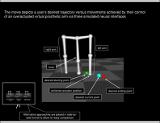| dc.contributor.author | Srinivasan, Lakshminarayan | |
| dc.contributor.author | da Silva, Marco | |
| dc.date.accessioned | 2010-12-15T07:55:04Z | |
| dc.date.available | 2010-12-15T07:55:04Z | |
| dc.date.issued | 2010-12-15 | |
| dc.identifier.uri | http://hdl.handle.net/1721.1/60298 | |
| dc.description | Supplementary movie for IEEE Transactions in Biomedical Engineering paper, "Breaking the fixed-arrival-time restriction in reaching movements of neural prosthetic devices", posted December 2010. | en_US |
| dc.description.abstract | This supplementary movie demonstrates three neural prosthetic algorithms in the simulated control of an overactuated 3-dimensional virtual robotic arm with a real-time inverse kinematics engine. Specifically, this movie compares the ability of these algorithms to generate movements with variously paced arrival times. Paper Abstract: We routinely generate reaching arm movements to function independently. For paralyzed users of upper-extremity neural prosthetic devices, flexible, high-performance reaching algorithms will be critical to restoring quality-of-life. Previously, algorithms called real-time reach state equations (RSE) were developed to integrate the user’s plan and execution-related neural activity to drive reaching movements to arbitrary targets. Preliminary validation under restricted conditions suggested that RSE might yield dramatic performance improvements. Unfortunately, real-world applications of RSE have been impeded because the RSE assume a fixed, known arrival time. Recent animal-based prototypes attempted to break the fixed-arrival time assumption by proposing a Standard Model (SM) that instead restricted the user’s movements to a fixed, known set of targets. Here, we leverage General Purpose Filter Design (GPFD) to break both of these critical restrictions, freeing the paralyzed user to make reaching movements to arbitrary target sets with various arrival times and definitive stopping. In silico validation predicts that the new approach, GPFD-RSE, outperforms the SM while offering greater flexibility. We demonstrate GPFD-RSE against SM in the simulated control of an overactuated 3-dimensional virtual robotic arm with a real-time inverse kinematics engine. | en_US |
| dc.language.iso | en_US | en_US |
| dc.rights | Attribution-Noncommercial 3.0 United States | en |
| dc.rights.uri | http://creativecommons.org/licenses/by-nc/3.0/us/ | en |
| dc.title | Supplementary Movie: Breaking the fixed-arrival-time restriction in reaching movements of neural prosthetic devices | en_US |
| dc.type | Animation | en_US |
